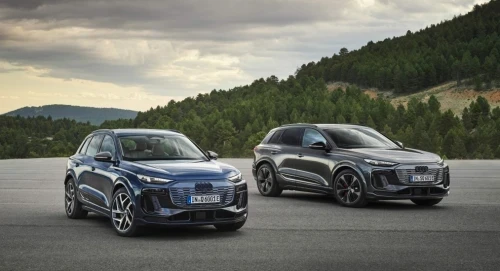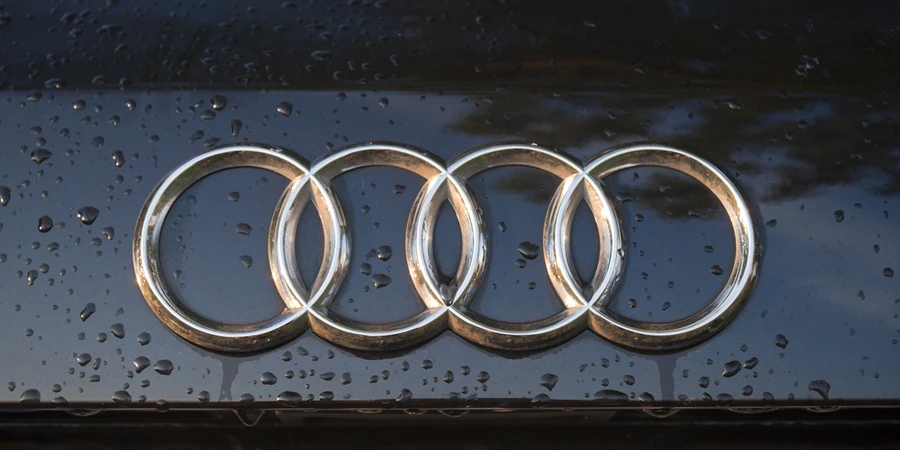The Audi Q6 e‑tron is the first production model on the Premium Platform Electric (PPE). The PPE, developed jointly with Porsche, and the E3 1.2 electronic architecture are important milestones in the expansion of Audi’s global range of electrically powered models.
Powerful, compact, and highly efficient electric motors, as well as a newly developed lithium-ion battery consisting of twelve modules and 180 prismatic cells with a total gross capacity of 100 kWh (94.9 net) ensure a range of up to 625 km (388 mi). (Earlier post.)
The new Audi Q6 e‑tron delivers a system output of 285 kW (power consumption in kWh/100 km combined: 19.4-17.0 (WLTP)); the SQ6 e‑tron delivers a system output of up to 380 kW when the extra function is engaged (power consumption in kWh/100 km combined: 18.4-17.5 (WLTP)).

At market launch, two model variants with all-wheel drive will be available, followed—depending on the market—by particularly efficient models with rear-wheel drive designed for range, which will also mark the entry into the Q6 e‑tron series.
The Q6 e‑tron quattro accelerates from 0 to 100 km/h (0-62 mph) in 5.9 seconds (combined power consumption in kWh/100 km: 19.4-17.0 (WLTP)). The SQ 6 e‑tron takes just 4.3 seconds (combined power consumption in kWh/100 km: 18.4-17.5 (WLTP)). The vehicles’ top speeds are 210 (130 mph) and 230 km/h (142 mph) respectively.
Two models with rear‑wheel drive will follow at a later date depending on the market. While one model will be designed for efficiency and range, the other will mark the entry into the Q6 e‑tron series.
With 800‑volt technology and a maximum charging capacity of 270 kW as standard, short charging stops are possible with the Audi Q6 e‑tron. Up to 255 km (158 mi) can be recharged in just ten minutes at an appropriate charging station (High Power Charging, HPC). The state-of-charge (SoC) increases from ten to 80 percent in around 21 minutes. Intelligent, high-performance and predictive thermal management is a key component of this charging performance.
Equipped with Plug & Charge, the vehicle authorizes itself at compatible charging stations when the charging cable is plugged in and commences the charging process. Charging is also fully automatic.
If a charging station works with 400‑volt technology, the Audi Q6 e‑tron can, for the first time, enable bank charging. The 800‑volt battery is automatically divided into two batteries at equal voltage, which can then be charged in parallel with up to 135 kW. Depending on the state of charge, both halves of the battery are first equalized and then charged simultaneously. AC charging with up to 11 kW is possible at standard home chargers.
An important component in increasing the efficiency and therefore the range of the Audi Q6 e‑tron is the advanced recuperation system. Around 95% of all everyday braking processes can be handled by this system. The Audi Q6 e‑tron recuperates at up to 220 kW.
E3 1.2 – high-performance and future-oriented electronic architecture. With the newly developed electronic architecture E3 1.2, customers experience digitalization in the vehicle more directly. The name E3 stands for End-to-End Electronic Architecture. During development, the overriding goal was to create a future-proof, standardized framework.
The function-oriented architecture is based on a new domain computer structure with five high-performance computers (High-Performance Computing Platform, HCP), which control all vehicle functions—from infotainment and driving functions through to semi-automated driving in later evolutionary stages.
The most powerful electronic architecture to date in terms of computing power is consistently geared towards customer requirements. One focus of development was on high-performance and secure networking of domain computers, control units, sensors, and actuators in order to master more complex systems and maintain modularity.
In addition, the E3 1.2 is characterized by a high-performance and seamless backend connection for Car-to-X swarm data applications and computationally intensive offboard functions. It is debuting in the Audi Q6 e‑tron, designed to be used across models, and forms the basis for future innovations.
Driving dynamics. Most of the systems and components making up to the chassis are newly developed. The suspension control systems involved are precisely coordinated with each other. The driving dynamics of the Q6 e‑tron are significantly influenced by the partially redesigned front axle. For the first time in an Audi model, the control arms are positioned in front of the suspension arms. This results above all in package advantages for the positioning of the high-voltage battery. The newly developed components lead to improved kinematic properties.
The steering rack is now fixed to a subframe. The refined axle kinematics provide noticeably increased driving dynamics. The new front axle also improves the steering behavior. This makes the vehicle feel significantly more agile.
The rear-biased torque distribution as part of a highly variable all-wheel drive system also enhances the dynamic driving characteristics of the Q6 e‑tron. The different dimensions of the electric motors on the rear and front axles enable rear-biased torque distribution even under full load. In order to complement the rear-biased weight distribution as well as to ensure even more grip and driving dynamics, the rear tires of the Q6 e‑tron are wider than those at the front.
Driver assistance systems. Audi provides a wide range of functions that significantly improve everyday driving and road safety for all road users. A new feature for the Q6 e‑tron is the adaptive driving assistant plus. It not only helps with acceleration, maintaining speed, keeping distance and lane guidance, but also uses high-resolution map data and swarm data from other vehicles aggregated in the cloud to improve the handling of the Q6 e‑tron.
The SUV uses the radar sensors, the front camera, and ultrasonic sensors for easy to operate guidance. The vehicle uses the collected information to create a virtual route and follows it dependably and as comfortably as possible across the entire speed range and in traffic jams.
Rear parking assistance, cruise control, lane departure warning, efficiency assist, active front assist and a distraction and drowsiness warning system are all on board as standard from launch. Customers have the option of further assistance systems and a safety package as part of various equipment packages.
The Audi Q6 e‑tron quattro and SQ6 e‑tron will be available to order from March 2024 at a price of €74,700 and €93,800 and will be delivered to customers in summer 2024.
The US will launch with the Q6 e-tron quattro and SQ6 e-tron SUV variants. Sportback and Rear Wheel Drive models will follow at a later point.
Source from Green Car Congress
Disclaimer: The information set forth above is provided by greencarcongress.com independently of Alibaba.com. Alibaba.com makes no representation and warranties as to the quality and reliability of the seller and products.




